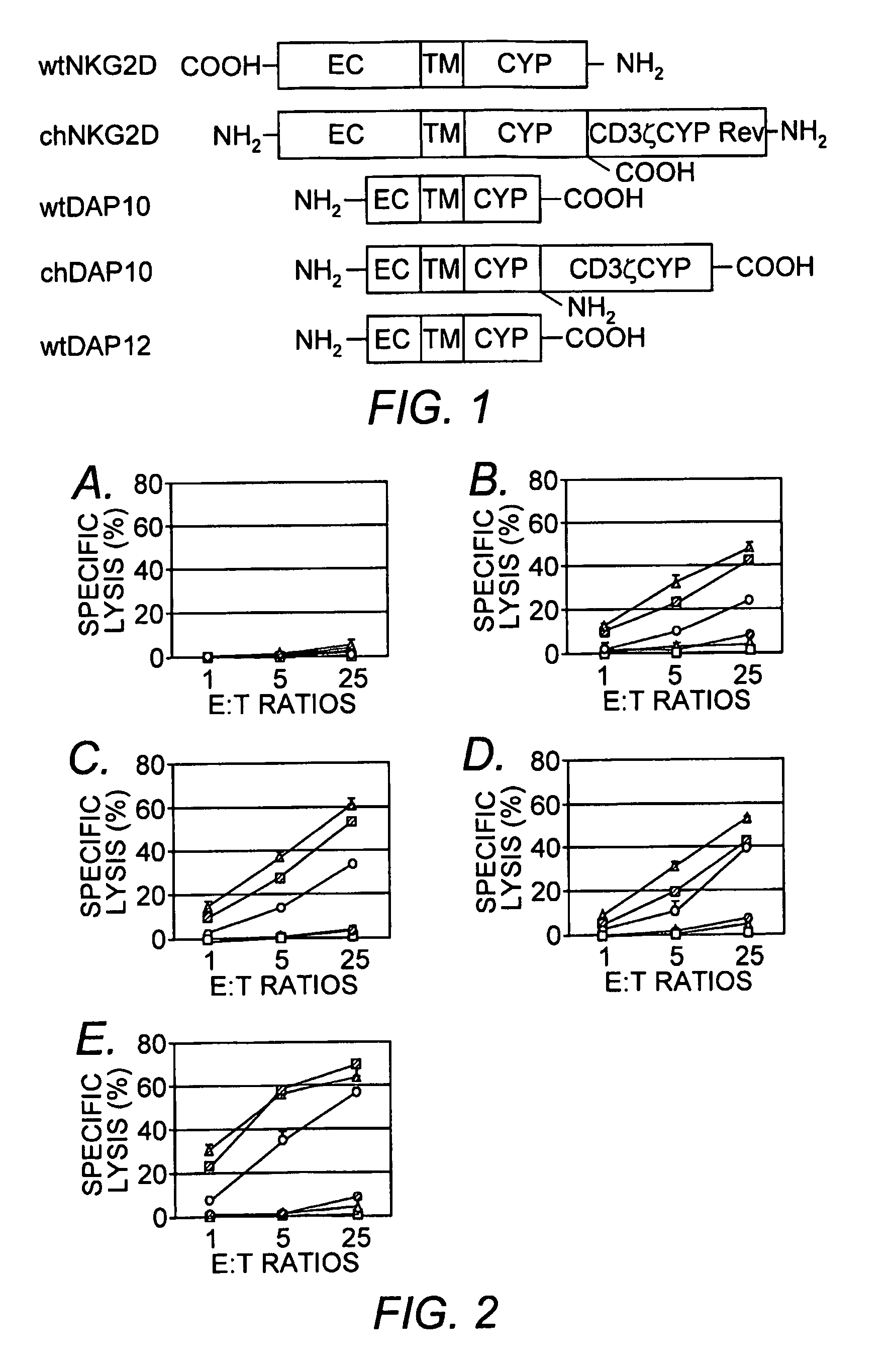Chimeric NK receptor and methods for treating cancer
a nk receptor and chimeric technology, applied in the field of chimeric nk receptor and methods for treating cancer, can solve the problems of time-consuming, laborious and sometimes difficult, and the isolation and expansion of t cells that retain their antigen specificity and function can also be a challenging task, so as to reduce or eliminate tumors, the effect of reducing or eliminating tumors
- Summary
- Abstract
- Description
- Claims
- Application Information
AI Technical Summary
Benefits of technology
Problems solved by technology
Method used
Image
Examples
example 1
Mice and Cell Lines
[0069]C57BL / 6 mice were purchased from the National Cancer Institute, and all animal work was conducted in accordance with standard guidelines.
[0070]Cell lines Bosc23, PT67, GP+E86, EG7 (H-2b), and YAC-1 were obtained from the American Type Culture Collection (ATCC, Rockville, Md.). RMA cells (H-2b) originated from a Rauscher virus-induced C57BL / 6 T-cell lymphoma (Ljunggren and Karre (1985) J. Exp. Med. 162:1745-1759). RMAS-S is a sub-line of RMA which lacks MHC class-I surface expression (Kärre, et al. (1986) Nature 319:675-678). All packaging cells were grown in Dulbecco's modified Eagle medium (DMEM) with a high glucose concentration (4.5 gram / liter) supplemented with 10% heat-inactivated fetal bovine serum (FBS; Hyclone, Logan, Utah), 20 U / mL penicillin, 20 μg / mL streptomycin, 1 mM pyruvate, 10 mM HEPES, 0.1 mM non-essential amino acids, 50 μM 2-mercaptoethanol. RMA, EG7, RMA-S and YAC-1 cells were cultured in RPMI plus the same supplements described above.
example 2
Retroviral Vector Construction
[0071]The full-length murine NKG2D cDNA was purchased from Open Biosystems (Huntsville, Ala.). Murine CD3ζ chain, Dap10 and Dap12 cDNAs were cloned by RT-PCR using RNAs from ConA- or IL-2 (1000 U / mL)-activated spleen cells as templates. Mouse NKG2D ligands Rae-1β and H60 were cloned from YAC-1 cells by RT-PCR. All PCR reactions were performed using high-fidelity enzyme Pfu or PFUULTRA™ (STRATAGENE®, La Jolla, Calif.). The oligonucleotides employed in these PCR reactions are listed in Table 9.
[0072]
TABLE 9SEQIDNo.PrimerSequenceNO:15′ wtNKG2DGCGAATTCGCCACCATGGCATTGATTCGTGAT8CGA23′ wtNKG2DGGCGCTCGAGTTACACCGCCCTTTTCATGCAG9AT35′ chNKG2DGGCGAATTCGCATTGATTCGTGATCGAAAGTC10T45′ wtDAP10GCAAGTCGACGCCACCATGGACCCCCCAGGCT11ACC53′ wtDAP10GGCGAATTCTCAGCCTCTGCCAGGCATGTTGA12T63′ chDAP10GGCAGAATTCGCCTCTGCCAGGCATGTTGATG13TA75′ wtDAP12GTTAGAATTCGCCACCATGGGGGCTCTGGAGC14CCT83′ wtDAP12GCAACTCGAGTCATCTGTAATATTGCCTCTGT15G95′ ATG-CD3ζGGCGTCGACACCATGAGAGCAAAATTCAGCAG16GAG103′ ATG-...
example 3
Retrovirus Production and Transduction
[0074]Eighteen hours before transfection, Bosc23 cells were plated in 25 cm2 flasks at a density of 4×106 cells per flask in 6 mL of DMEM-10. Transfection of retroviral constructs into Bosc23 cells was performed using LIPOFECTAMINE™ 2000 (INVITROGEN™, Carlsbad, Calif.) according to the manufacturer's instruction. Viral supernatants were collected 48 and 72 hours post-transfection and filtered (0.45 μm) before use. For generation of large scale, high-titer ecotropic vectors, the ecotropic viruses produced above were used to transduce the dualtropic packaging cell PT67 in the presence of polybrene (8 μg / mL). After three rounds of transduction, PT67 cells were selected in G418 (1 mg / mL) for 7 days. Dualtropic vectors were then used to transduce ecotropic cell line GP+E86. Through this process, the virus titer from pooled GP+E86 cells generally was over 1×106 CFU / mL. Concentration of retroviruses by polyethylene glycol (PEG) was performed according ...
PUM
 Login to View More
Login to View More Abstract
Description
Claims
Application Information
 Login to View More
Login to View More - R&D
- Intellectual Property
- Life Sciences
- Materials
- Tech Scout
- Unparalleled Data Quality
- Higher Quality Content
- 60% Fewer Hallucinations
Browse by: Latest US Patents, China's latest patents, Technical Efficacy Thesaurus, Application Domain, Technology Topic, Popular Technical Reports.
© 2025 PatSnap. All rights reserved.Legal|Privacy policy|Modern Slavery Act Transparency Statement|Sitemap|About US| Contact US: help@patsnap.com

